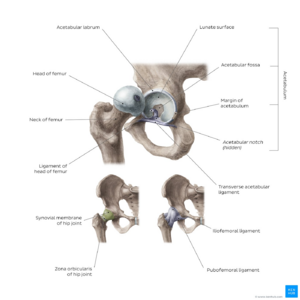McCarthy test: Difference between revisions
Hunter Logan (talk | contribs) mNo edit summary |
No edit summary |
||
| Line 38: | Line 38: | ||
=== Evidence === | === Evidence === | ||
The McCarthy Test has never been subject as the single form of diagnostic studies, which is why the clinical value remains questionable.<ref>Physiotutors. McCarthy Test | Femoroacetabular Impingement (FAI). Available from: https://www.youtube.com/watch?v=To4r0YQI6Nc</ref> | The McCarthy Test has never been subject as the single form of diagnostic studies, which is why the clinical value remains questionable.<ref>Physiotutors. McCarthy Test | Femoroacetabular Impingement (FAI). Available from: https://www.youtube.com/watch?v=To4r0YQI6Nc</ref> Because of there being uncertainty in theclinical value of the McCarthy Test consistent evaluation of the patient’s subjective report is important throughout examination. Limitations in active and passive range of motion along with arthrokinematic deviations at the hip can be presented by antalgic gait abnormalities which would be an indication further test should be used to rule out other possible intra-articular hip disorders. | ||
== Related Tests == | == Related Tests == | ||
Revision as of 03:07, 15 April 2022
Original Editors - Add your name/s here if you are the original editor/s of this page. User Name
Top Contributors - Hunter Logan, Kim Jackson, Aminat Abolade, Baile Louderback, Robert Storrow, Olajumoke Ogunleye, Kenny Bosmans, George Prudden, Wanda van Niekerk and Cindy John-Chu
Description[edit | edit source]
The McCarthy Test is a clinical test used to aid in the diagnosis of a hip labral tear. The shearing force producing painful popping, clicking, or catching while performing the test indicates a possible hip labrum tear.[1]
Clinically Relevant Anatomy[edit | edit source]

The acetabulofemoral (hip) joint is the largest and most stable joint in the human body. The acetabular labrum is a soft-tissue structure which, lines the acetabular rim of the hip joint.[3]The joint is surrounded by ligaments that work to keep this articulation intact. Movements of this joint are facilitated by the articulation of the acetabulum and the labrum. In normal hip joint biomechanics, the labrum is crucial in retaining a layer of pressurized intra-articular fluid for joint lubrication and load support/distribution.[3] Its seal around the femoral head is further regarded as a contributing to hip stability through its suction effect.[3]
Click here for more detailed information on the anatomy on the hip joint.
Technique[edit | edit source]
Step 1: The patient should be laying supine with their head supported and with both arms rested to their side in a comfortable position.
Step 2: The examiner should then passively flex the affected hip to end range.
Step 3: The clinician should then externally rotate the hip as the leg is moved back into extension.
Step 4: Repeat steps 1 and 2 but internally rotate the hip as the leg is moved back into extension.
How to do the McCarthy Hip Test for a Labral Tear - YouTube[1]
Differential Diagnosis[edit | edit source]
Acute hip pain conditions can include:
- Fractures
- Tumors
- Infection
- Osteoarthritis
- Avascular necrosis
- Adductor pathologies
Evidence[edit | edit source]
The McCarthy Test has never been subject as the single form of diagnostic studies, which is why the clinical value remains questionable.[4] Because of there being uncertainty in theclinical value of the McCarthy Test consistent evaluation of the patient’s subjective report is important throughout examination. Limitations in active and passive range of motion along with arthrokinematic deviations at the hip can be presented by antalgic gait abnormalities which would be an indication further test should be used to rule out other possible intra-articular hip disorders.
Related Tests[edit | edit source]
References[edit | edit source]
- ↑ 1.0 1.1 The Physio Channel. How to do the McCarthy Hip Test for a Labral Tear. Available from: https://www.youtube.com/watch?v=Kz-lDYflamI&t=4s
- ↑ Ken Hub. Hip Joint. Available from: https://www.kenhub.com/en/library/anatomy/hip-joint
- ↑ 3.0 3.1 3.2 Bsat S, Frei H, Beaulé PE. The acetabular labrum: a review of its function. The Bone & Joint Journal. 2016 Jun;98(6):730-5.
- ↑ Physiotutors. McCarthy Test | Femoroacetabular Impingement (FAI). Available from: https://www.youtube.com/watch?v=To4r0YQI6Nc






